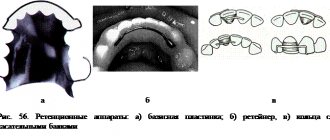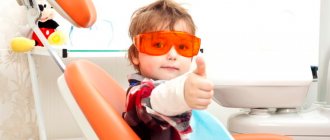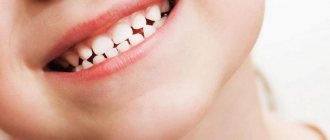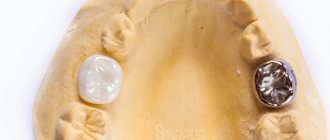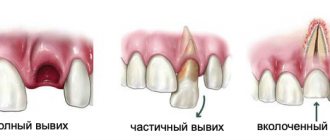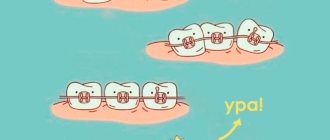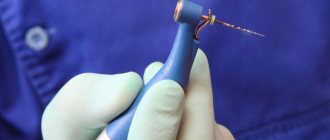Timely treatment of caries in baby teeth is even more important than treatment of permanent teeth. And that's why:
- Normal eruption of permanent teeth and bite formation largely depend on the health and timely replacement of baby teeth. A complete set of primary teeth forms the correct jaw dimensions. If they are destroyed by caries and fall out or are removed ahead of time, then the jaw may not form as desired. This is highly likely to lead to malocclusion in the future or crooked teeth and unsightly alignment. As a result, a child, having matured, will pay for untreated caries in a baby tooth, at best, with braces, at worst, with teeth in a checkerboard pattern and psychological complexes. Losing (or removing) baby teeth too quickly can easily lead to malocclusion in the future.
- Caries on baby teeth can be complicated by pulpitis and periodontitis, which can cause cysts to appear in the root zone, as well as damage to the permanent tooth germ.
- Advanced caries is often a reason for ridicule in children's groups.
- Also, do not forget that the appearance of caries is a sign of poor oral hygiene, an incorrect diet or a lack of minerals in the diet, and sometimes a symptom of problems with the immune system. If you ignore these problems at the beginning of life, then by the middle of his life the child may arrive without healthy teeth at all and with a set of concomitant diseases.
- If chewing baby teeth are removed early, the child will not be able to chew food normally. As a result, an insufficiently processed food bolus will enter the gastrointestinal tract, which can lead to digestive disorders
Often parents do not treat even serious forms of caries complications, and periodontitis in a child can turn into periostitis, osteomyelitis, abscess or phlegmon. Moreover, the level of deaths among children from complications of caries is higher than in adults, since with certain factors that weaken the immune system, the process from pulpitis to abscess and phlegmon in a child can take a matter of days and even occur within 24 hours.
Content:
- Should baby teeth be treated?
- The most common dental diseases in childhood
- Treatment of baby teeth
- Anesthesia in pediatric dentistry
- What to do to avoid having to treat baby teeth
Parents often shake their heads negatively when asked whether baby teeth need to be filled. It seems to them that it is not at all necessary to do this, because very soon the temporary bite will be replaced by a permanent one. Dentists categorically disagree with this opinion. Doctors say that you need to take care of the health of your milk units just as thoroughly as your primary ones.
Why is it important to preserve your child's primary teeth?
You need to fight decisively for every baby tooth, because it depends on:
- chewing function: nutrition directly affects the development of the body, the child should eat with pleasure and without any discomfort;
- speech formation: correct articulation depends on the teeth, therefore, they are necessary for the child to speak clearly and understandably;
- development of the dental system: premature loss of baby teeth leads to serious displacement of neighboring teeth, which causes the loss of space for a permanent tooth and changes the bite;
- psychological status: a child settling into society is vulnerable, anything can shake his self-esteem, and he needs a wide, white-toothed smile more than ever.
Should baby teeth be treated?
There are a number of reasons why it is imperative to take care of your child’s baby teeth. Among them:
- Negative changes in the bite in the case of premature destruction of individual teeth, violation of the location of permanent units. Because of this, in adolescence, a child has to wear braces, which cause him a lot of physical inconvenience and psychological complexes.
- The risk of infection transferring from a baby tooth to the permanent bud. These complications are possible with pulpitis, cysts, periodontitis. Bacteria can also penetrate bone tissue, and this is very dangerous for the health of a small patient.
- The development of diseases of the gastrointestinal tract as a result of premature destruction of dental crowns. Then the smile becomes partially toothless and it is difficult for the child to chew food. If large pieces of food enter the stomach, digestive processes worsen and slow down.
- Problems with diction and sound pronunciation. A “toothless” mouth contributes to the development of a lisp. Because of this, the child may be criticized by peers.
Also, when talking about whether it is necessary to treat baby teeth, doctors never tire of reminding them of the pain that a child faces if the dental disease that has arisen progresses. Is it worth exposing your baby to such torture? After all, they can be easily avoided by promptly treating temporary canines, incisors and molars.
What is caries
Caries is a pathological process that appears after teething, under the influence of various factors and subsequently leads to the formation of a cavity (“hole”).
The cause of caries in primary teeth can most often be a violation of carbohydrate intake. For example, if parents give their child sweet water, juices, or milk at night. This type of caries is called “bottle caries”. All this happens due to the fact that at night the natural self-cleaning of the oral cavity does not occur, the amount of saliva decreases, and it is this that neutralizes the acid that is formed.
Caries can also cause further development of complications such as: pulpitis, periodontitis, etc., not to mention the fact that baby teeth, like permanent teeth, have nerves and they can also hurt. All this causes children no less pain than adults.
The most common dental diseases in childhood
Among the main problems that force children to undergo dental treatment:
- Caries. Children encounter it most often. The disease is found in more than 60% of children under six years of age. It especially often affects molars. This is due to their relief volumetric surface and the baby’s nutritional conditions. On the crown of molars, plaque is deposited more actively. Pathogenic microorganisms multiply in it. The result of their life activity is progressive caries. The difficulty is that in the first stages, parents are not always able to detect a carious cavity on their own. It looks like a light speck and practically merges with the healthy surrounding enamel. Not knowing about the presence of the disease, mothers and fathers postpone a visit to the pediatric dentist. When the child arrives for an appointment, the carious “hollow” already turns out to be very large.
- Periostitis (flux). A complication of advanced caries, caused by the spread of bacteria, damage to tooth roots and tissues adjacent to them. The cheek is swollen. A voluminous abscess forms on the surface of the gum. When palpated, acute pain occurs. Flux may worsen the baby's general condition.
- Periodontitis. Inflammatory periodontal disease. The latter is formed by: periodontal ligament, gums, root cement and alveolar bone. It hurts your baby to bite into hard food. His temperature rises and headaches appear.
All of these dental diseases are highly treatable. The most important thing is not to put off visiting a dental clinic until later.
Treatment of baby teeth
fluoridation
comes to the rescue . The enamel is treated with a fluorine-containing compound. Due to which it becomes stronger, the progression of the carious lesion is inhibited.
Advanced caries, like pulpitis and periodontitis, requires a filling procedure. It is carried out using local anesthetics, so neither the child nor his parents should be afraid of pain or severe discomfort.
When treating the roots of milk units, doctors use a special material, which in the future will be absorbed along with the roots. Thus, the treatment in no way changes the order of tooth replacement.
Anesthesia in pediatric dentistry
What type of anesthesia will be used during treatment depends on the degree of advanced disease. Most often, doctors use a spray that makes the gum tissue insensitive.
If the problem is serious, injectable painkillers are used. But so that the little patient does not feel pain during the injection, the doctor first lubricates the area where the needle is inserted with an anesthetic. This approach to pain relief makes even complex dental procedures not at all scary and as comfortable as possible for the little fidget.
General anesthesia in pediatric dentistry is used only for the most severe illnesses or if it is not possible to persuade the patient to open his mouth and sit quietly in a chair. Parents should not be alarmed if the doctor recommends general anesthesia. It involves the use of a modern, safe drug with a minimum number of side effects.
What to do to avoid having to treat baby teeth
In order not to have to wonder whether it is necessary to treat baby teeth, it is necessary to pay maximum attention to preventive measures. These include:
- proper and regular brushing of teeth;
- visiting the dentist twice a year (or more often if the child is prone to dental diseases);
- using a high-quality toothbrush and toothpaste;
- balanced diet, avoiding eating a lot of sweets;
- rinse your mouth after every meal.
If you take care of your teeth, the risk of tooth damage will be much lower. This means that a visit to the dentist will mostly be associated with affordable and absolutely painless prevention.
Are baby teeth an important stage in development or a temporary phenomenon?
Teeth, the quality of our life largely depends on them - first milk teeth, then permanent teeth. And then - how does it work out? And if at a conscious age one can safely address the statement to teeth with “you value it when you lose it,” then parents, as a rule, treat their children’s temporary “pearls” quite dismissively: “they will fall out...” Due to this undeniable fact and the constant lack of time among parents, insufficient attention is paid to brushing teeth. Let’s add here store-bought juices with a lot of sugar, cookies from loving grandmothers for their pampered children, sweets from attentive guests and the almost complete absence of solid food in the child’s diet - it turns out that a dental surgeon often helps teeth “fall out.”
Statistics show that already at the age of 4, up to 9% of children have extracted teeth. And, unfortunately, by the age of 6-8 years the number of such children reaches 60%.
But complicated caries is not always the reason for the removal of baby teeth.
The reasons leading to the destruction of the crown parts of teeth or their early loss include:
- ineffective prevention or its absence during the prenatal period, during the embryonic development of the fetus and during breastfeeding;
- insufficient prevention during the period of primary, mixed and permanent dentition (timely treatment of primary teeth is of great importance for the prevention of caries complications and the prevention of early tooth loss);
- retention (non-eruption of a tooth), partial or complete primary adentia (absence of tooth buds).
- injuries;
— enamel hypoplasia (incorrect or incomplete development of tooth enamel, the main causes of which are acute infections during pregnancy, hereditary factors, etc.).
When is it necessary to remove baby teeth?
1. Significant defects in the crown of the tooth, in which restoration of the tooth is not possible.
2. Chronic periodontitis (inflammation of the tissue around the tooth), complicated by purulent processes.
3. The period of physiological tooth change (when the permanent tooth is already visible in the oral cavity, but the milk tooth has not fallen out).
Why is it so important to preserve baby teeth until they are physiologically replaced by permanent teeth?
Milk teeth contribute to the correct formation of a correct permanent bite, and therefore important body functions in which the dentofacial system takes part, such as breathing, chewing, swallowing, speech.
Let's look at some facts that prove the importance of dental function .
A child's usual diet contains a large amount of carbohydrates, the breakdown of which requires thorough chewing of food and wetting it with saliva. In the absence of teeth, especially molars, chewing deteriorates, which leads to a delay in the physiological development of the jaws (the performance of the masticatory muscles decreases, the structure of the bone tissue of the jaw areas with extracted teeth is not fully formed) and the body as a whole.
When teeth are lost, the position of the tongue changes, which is placed in the resulting space, promoting the formation of an open bite (the presence of a pathological vertical gap between the teeth of the upper and lower jaws) and interfering with the correct eruption of permanent teeth.
Early loss of natural teeth in children without timely replacement of defects in the dentition leads to various changes in the dental system.
These include the following.
1. Changing the position of teeth adjacent to the lost one towards the resulting space (up, down, forward, backward, around the axis):
a) the absence of upper primary incisors leads to a noticeable flattening of the upper lip, protrusion of the lower lip, and displacement of the lower incisors forward.
b) in children , when they lose antagonists (teeth of the opposite jaw), unlike adults, the teeth very quickly change their position together with the alveolar process until they come into contact with the alveolar process of the opposite side, which is explained by a tendency to growth, which is not yet completed. The dental arches are bent not only in the vertical, but also in the horizontal direction, either towards the tongue or towards the cheek (dentition becomes asymmetrical).
c) with the loss of primary molars or canines , the overlap in the anterior-posterior direction increases, a so-called distal bite is formed, the first permanent molars shift to the center of the jaw, as a result of which the dental arch is shortened.
2. Reduced bite height.
3. Changing the position of the lower jaw forward, backward, to the side.
4. Changes in the relationships of the elements of the temporomandibular joint, which can be asymptomatic in the first period of development of the deformity. If the elements of the joint are not returned to their previous position with the help of orthopedic devices, such conditions often become pathological, such as arthritis, arthrosis, arthrosis-arthritis.
5. Early removal of baby teeth leads to the fact that the permanent tooth germ lying deep in the jaw is covered with a dense layer of bone, which is an obstacle to the eruption of a permanent tooth.
Particular attention should be paid to the first permanent molars , which are most often affected early by caries. They are of great physiological importance for the proper development of the jaw and the growth of the facial skeleton. They bear the main chewing load for up to 12 years, holding the premolars and seventh teeth in the correct position, and preventing secondary bite deformation.
If the first molars move forward due to early removal of primary molars, there may be a shortage of space for permanent canines and they will erupt outside the dentition.
Krolivets Tatyana Grigorievna,
Orthodontist of the first category,
Candidate of Medical Sciences,
Dental clinic "Implantis".
https://implantis.com.ua/
published 09/07/2012 09:49 updated 03/13/2014 - Diseases of the teeth and oral cavity
